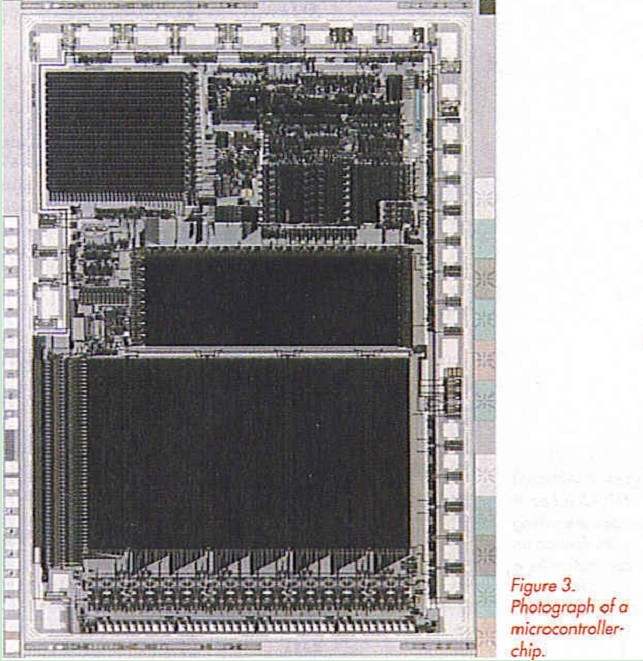

Project Solutions
Trends in Microcontroller (3)
Published:2011/7/31 21:06:00 Author:Phyllis From:SeekIC
By Christian Tavernier
Applications
Especially in cars, the use of microcontrollers is becoming increasingly important. This has resulted in manufacturers not only integrating CAN-bus controllers on their chips but the microcontrollers themselves are becoming more advanced. This is the case, for example, with the 18F2332 from Microchip, which can operate at 40 MHz. The same is true for the MC68HC908MRx from Motorola.
Even in this ocean of digital chips, the analogue world has not been forgotten. These days, all manufacturers have ICs in their product catalogues with advanced analogue/digital-converters. An example is the ATmegal 28 from Atmel. It contains a 10-bit, 8-channel model, which operates in normal mode (single ended) as an 8-channel converter. 7-channel differential mode is also possible and 2 channels are provided with an integrated programmable amplifier (1 to 200 times). For many applications there is no longer the need to resort to an external converter. The addition of internal peripherals has no negative impact on the amount of memory. On the contrary, the better-endowed ICs often contain memories of amazing size. Table 1 provides an overview of the three ’largest’ presently available microcontrollers from Microchip (the 18Cxxx-family), from Atmel (the ATmega-family) and from Motorola (the HCS12-family). Conspicuous in this table is the MCS12H256B from Motorola (Figure 3) v/with the overwhelming 99 parallel l/O-lines and 256K-Flash memory. This is quite a bit different than the 68705P3 with 20 l/O-lines and 1.6K-memory. 

Phoenix
You know, the mythical bird that rose from its own ashes. There is a microcontroller that we certainly have to give some attention despite the fact that we’re now in the second half of 2004: the 8051. Even though this microcontroller, in its basic form, first appeared on the market at the end of the 80’s, it is still the basis for many new developments.
Despite its respectable age, the 8051 has survived thanks not only to the addition of new internal peripherals and expansions to the program memory, but also additional features that used to be considered impossible (such as in-circuit-programming, discussed further on in this article).
If the 8051 assembler doesn’t hold any secrets for you any more, then you should take a look at the AT89xxx family from Atmel. All ICs in this family were developed from the 8051, but have in-circuit-programming, new internal peripherals and expanded program memories. If you find that these ICs are a little too ’well-done’ then maybe the new Philips family P89LPC900 has something to offer you. If this name doesn’t mean anything to you then you should dive into your Eleklor Electronics archive For the October and November 2003 issues in which this IC was discussed extensively.
Programs and development tools
Initially, that is to say, when a microcontroller barely contained 1 or 2 kB of memory, programming in assembler was the only real option. The available memory would easily have been filled v/with a few lines of a higher programming language, because a single line usually results in numerous lines of assembly language as a result of the ’expansion urge’ of the compiler.
The assembler is still an indispensable tool if we want to create a genuine real-time program or if we want to obtain the greatest possible performance out of the microcontroller. But these days, the preference is to use a higher programming language. Most programmers now select either BASIC or C in preference to assembly. There are now C compilers for all microcontroller families. This varies from the quite pricey products such as the CCS C PIC compiler to the freeware PlCC-Lite C compiler from Htsoft, which is often sufficient for many applications.
For those who prefer not to work in C or assembler there are excellent BASIC-compilers, such as the PicBasic Pro Compiler from Micro Engineering Labs and Proton from Crownhill Associates. For the AVR-family from Atmel you could use Bascom AVR from MCS Electronics.
Reprinted Url Of This Article: http://www.seekic.com/blog/project_solutions/2011/07/31/Trends_in_Microcontroller__(3).html
Print this Page | Comments | Reading(1441)
Article Categories
New published articles
· Imagination works with TSMC to develop FinFET process
Author:Ecco Reading(33527)
· XMOS pushes event-driven MCUs with lower price
Author:Ecco Reading(3534)
· Intel brings upgraded 32-nm SoC for smartphones
Author:Ecco Reading(3250)
· Micron pushes TLC 128-Gbit NAND flash
Author:Ecco Reading(3816)
· Intel will stop supplying desktop motherboards
Author:Ecco Reading(5341)
· Processor market was expected to regain strength in 2013
Author:Ecco Reading(3318)
· It was reported that TSMC sales fall steeply
Author:Ecco Reading(3474)
· Cisco, NXP work with auto wireless startup
Author:Ecco Reading(3620)
· Micron was impacted by manufacturing glitch
Author:Ecco Reading(4017)
· China can make 22-nm transistor by themselves
Author:Ecco Reading(3820)
· Chip market rebound is coming, according to survey
Author:Ecco Reading(3761)
· Sony, Toshiba will spend more on chips, iSuppli reports
Author:Ecco Reading(3790)
· Qualcomm becomes the 13th company to join NFC Forum board
Author:Ecco Reading(6105)
· TSMC increases building work for FinFET fab
Author:Ecco Reading(3778)
· TI plans to cut 1,700 jobs in OMAP shift
Author:Ecco Reading(4587)